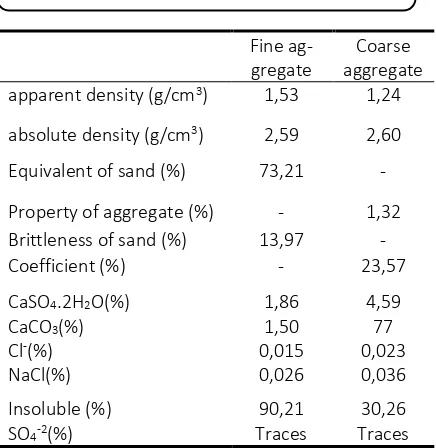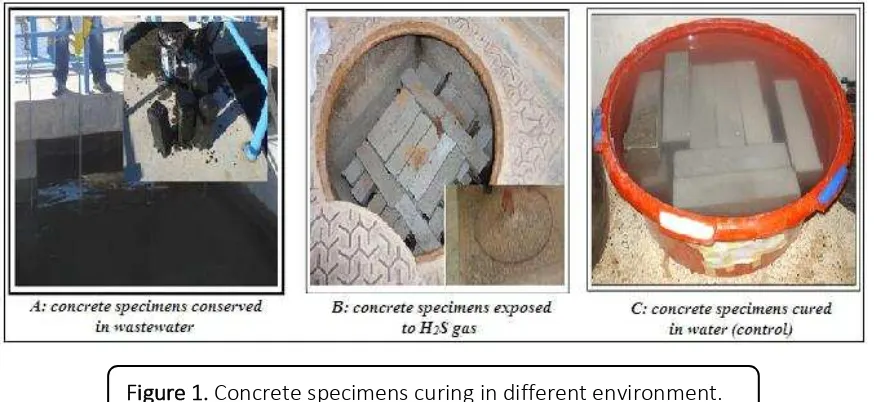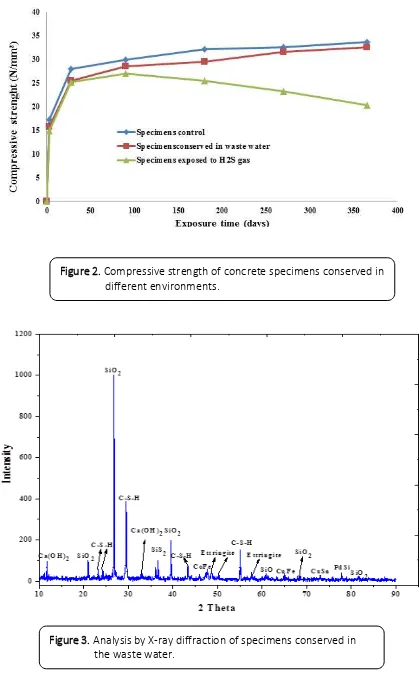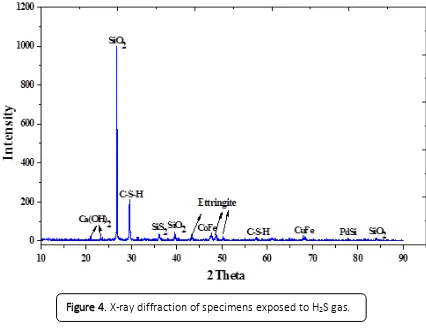Study on Durability of the Concrete of Sanitation
Network in Ouargla Algeria Under the Existence of
Sulphates Attack
Mohammed-Amin Boumehraz 1*, Mekki Mellas 2, Abdelouahed Kriker 3
1,2 Department of civil engineering, faculty of science and technology, university of Biskra – Algeria. 3Department of civil engineering, faculty of applied sciences, university of Ouargla – Algeria.
*Correspondence: E-mail: amine18gc@yahoo.com
A B S T R A C T S A R T I C L E I N F O
The objective of this research was to evaluate pipes for do-mestic applications in Ouargla Algeria. The experiment proce-dure was done by investigating the sanitation networks as a function of type of pipes, concrete used, and waste concen-tration (as sulfates and hydrogen sulphide composition).The analysis was also completed by the comparison between the realistic pipe condition and the pipe specimen control in la-boratium. The results showed that decreases in mechanical strength of the pipe were obtained. The compressive strength of the specimens has decreased down to 3% after 1 year. When exposing the specimen to hydrogen sulphide gas, a rapid deterioration was obtained since 90 days of expossure. Further, the worst change in compressive strength was found, in which the reduction of compressive strength was found down to 40%.
© 2018 Tim Pengembang Jurnal UPI
Article History:
Received 30 November 2017 Revised 03 January 2018 Accepted 19 February 2018 Available online 09 April 2018
____________________ place connect the sanitary with the sewer sys-tem. Although most sewer system is classified as a domestic-type wastewater, the sanitary seemed to be beyond the standard from do-mestic wastewater. The main reason is be-cause this saintary system has a correlation to the discharged wastewater from industry.
Indeed, this could be from the inappropriate wastewater treatment (Boumehraz & Mellas, 2017).
The other factor obtained from this sani-tation is the high contamination of sulphates and hydrogen sulfide (H2S) (Nielsen & Hvitved-Jacobsen, 1988). It is also reported that the concentration of these contaminants depends on the temperature and relative hu-midity, and the maximum values are obtained in summer session (Pebriyanti et al., 2016).
Indonesian Journal of Science & Technology
The gas sometimes reaches concentration of 100 ppm.
H2S gas is usually created as a result of or-ganic decomposition in anaerobic bacterial process. The concentration of this gas must be considered and has a threshold at 3 to 6 mg/L (Estoup & Cabrillac, 1997). Although H2S gas can be oxidized when contacting with air by aerobic bacteria, the existence of this chemical is toxic. Further, to oxidize H2S, 2% to 6% of oxygen (O2) is required. Although the oxidation is good to decrease the toxicity of the H2S, the oxidation process creates problems because of the sulphate formation that can corrode pipe (Ryckebosch et al., 2011). In other problems, when H2S gas con-denses on the walls of sewer networks, H2S is converted by anaerobic bacteria, reacting with moisture to form a strong and highly cor-rosive acid to the plates as sulfuric acid (H2SO4) (Jensen et al., 2011).
In the case of pipe, most of the compo-nents are gypsum. The gypsum (CaSO4.2H2O) is obtained by the reaction between portland-ite (Ca(OH)2) and the outer sulphates. The ettringite formation (C3A.3CaSO4.32H2O) is the result of the reaction between gypsum and anhydrous calcium aluminate. The reaction for the formation of these materials involved sodium sulphate (Na2SO4) and mag-nesium sulphate (MgSO4) with calcium hy-droxide (Bassuoni and Nehdi, 2009; Prasad et al., 2006). The reaction can written as
The additions of pozzolane during the hy-dration of cement can increase the
mechanical strength and reduce the reaction with the calcium aluminate (C3A) of about to 8% (Bassuoni & Nehdi, 2009).
The contact between the sulphuric acid and portlandite (Ca(OH)2) results gypsum (CaSO4.2H2O). Then, the contact between the gypsum and the anhydrous calcium aluminate (C3A) forms ettringite (3CaO.Al2O. 3CaSO4.3H2O). Finally, ettringite is a friable material that forms from the incomplete re-action of the sulphuric acid and the cement paste (Eštokovet al., 2012).
Messaoudene obtained a reduction of compressive strength by 41% (Messaoudene et al., 2012). When temperature is lower then 15C, the thaumasite (CaSiO3.CaCO3. CaSO4.15H2O) was formed. This material is produced by reactions between the hydrated calcium silicates (CSH), sulfates, and car-bonates ions (Bassuoni & Nehdi, 2009).
SO4−2 + 3Ca+2 + 3CO3−2 + 3SiO3−2 + 15H2O → 3CaOSiO2.CO2.SO3.15H2O Here, the present work was to investigate degradation mechanism and physicochemical of organic material in concrete specimens in the real aggressive environment as the build-ing blocks of pipes and manholes used to san-itation in the Ouargla region. This information is important since the organic material can results other chemicals and can not be predicted easily (Permatasari et al., 2016; Anshar et al., 2016). The organic materials can be changed by the additional oxygen and light (Nandiyanto et al., 2016). We believe that this research will give information regarding the strategies for against corrosion phenomena.
This study used prismatic mold dimen-sions (70x70x280) mm3 according to Euro-pean standards NF EN 12390-1 and NF P 18-427, for the manufacture of concrete mens. After pouring the concrete, the speci-mens were kept in the molds in the indoor lab for 24 hours, for curing concrete. Table 1 sum-marizes the concrete mixture compositions of sample. The cement used are Sulphate Re-sistant Cement (CEM I 42.5 N-ES) from the Lafarge company. Physicochemical properties of the cement are shown in Table 2.
Component Unit
Cement (Kg/m3) 400
Fine aggregate (Sand) (kg/m3) 621.53 Coarse aggregate (kg/m3) 1182.23
W / C 0.54
Notes Unit
Normal consistency in cement paste (%) 26.4
Mass per unit volume (g/cm3) 3.08 Finesse according to Blaine's method 3320 Compressive strength 28 days (MPa) 28.90 Initial time of setting (min) at 20 ° C 140 coarse aggregate and the fine aggregate used
are presented in Table 3. The maximum size of coarse aggregate was 15 mm, and the max-imum size of fine aggregate or sand was 5 drinking water condition (temperature of 20 ± 2 °C). Other specimens were conserved in the basin of waste water in the Ouargla. Chemical analysis of waste water in the basin is shown in Table 4.
The last specimen is exposed to hydrogen sulphuric (H2S) gas, which is placed in a man-hole closed of the Ouargla aiming to ensure a high concentration of H2S. Figure 1 presents concrete specimens curing in different envi-ronment conditions.
Table 1. Proportions of tested concrete mix-tures
Table 2. Physical and chemical properties of ce-ment
Table 3. Physical and chemical properties of ag-gregate
3. RESULTS AND DISCUSSION
Compression test was conducted in the lab by using of prismatic specimens (70x70x70 mm) according to European Stand-ard EN 12390-3. The results of compressive strength the concrete specimens conserved in different environment are presented in Fig-ure 2.
As shown in Figure 2, the compressive strength of the specimens control is greater than those specimens preserved in the waste water. The specimen exposed with H2S gas is the lowest for compressive strength value. The compressive strength for specimens con-served in waste water increases continuously up to 365 days, and the maximum value of strength reaches is 32.65 MPa. For the speci-mens exposed to H2S gas, the value of com-pressive strength increases continuously up to 90 days, where the maximum strength is 37.04 MPa. But, from 90 to 365 days, the value of compressive strength reduced down to 20.41 MPa. The results confirmed the neg-ative effect of H2S gas on durability of con-crete.
The X-ray diffraction analysis shows the skin of concrete specimens preserved in
different environment conditions (Figure 3 and 4). As shown in the figures, the formation of ettringite was found in specimen exposed with H2S gas (detected in peaks of 43, 48, and 50). The formation of portlandite for speci-men conserved in waste water was found at peaks of 12 and 32. The results confirmed the acceleration for degradation of the speci-mens exposed to H2S.
4. CONCLUSION
The conservation of pipe must be considered since the physicochemical properties of pipes change when contacting with chemicals. It is found that the concrete specimens in wastewater decreases by 3% for compressive strength after 365 days. For con-crete specimens exposed to H2S gas, rapid de-terioration was found after 90 days. Then, when exposing H2S gas from 90 to 365 days, reduction in strength to 40% was found. The change of mechanical strength is due to corrosion phenomena as an impact from the existence of H2S. Thus, for increasing durabil-ity of pipe and manholes in Ouargla, substitu-tion of pipe and manhole by other material is important.
Figure 2. Compressive strength of concrete specimens conserved in different environments.
5. ACKNOWLEDGEMENTS
The authors wish to thank university of Biskra and university of, Algeria.
6. AUTHORS’ NOTE
The author(s) declare(s) that there is no con-flict of interest regarding the publication of this article. Authors confirmed that the data and the paper are free of plagiarism.
5. REFERENCES
Anshar, A. M., Taba, P., & Raya, I. (2016). Kinetic and Thermodynamics Studies the Adsorption of Phenol on Activated Carbon from Rice Husk Activated by ZnCl2. Indonesian Journal
of Science and Technology, 1(1), 47-60.
Bassuoni, M. T., & Nehdi, M. L. (2009). Durability of self-consolidating concrete to sulfate attack under combined cyclic environments and flexural loading. Cement and Concrete
Re-search, 39(3), 206-226.
Boumehraz, M. A., & Mellas, M. (2017). Evaluation on the durability of concrete sanitation network of Ouargla-Algeria by non-destructive testing. Malaysian Journal of Civil
Engi-neering, 29(3), 320-332.
Eštokov, A., Harbuľáková, V. O., Luptáková, A., & Števulová, N. . Study of the deteriora-tion of concrete influenced by biogenic sulphate attack. Procedia Engineering, 42, 1731-1738.
Estoup, J. M., & Cabrillac, R. (1997). Corrosion of biological origin observed on concrete diges-tors. Construction and Building Materials, 4(11), 225-232.
Jensen, H. S., Lens, P. N., Nielsen, J. L., Bester, K., Nielsen, A. H., Hvitved-Jacobsen, T., & Vol-lertsen, J. (2011). Growth kinetics of hydrogen sulfide oxidizing bacteria in corroded concrete from sewers. Journal of hazardous materials, 189(3), 685-691.
Messaoudene, I., Jauberthie, R., Molez, L., Rangeard, D., and Naceri, A. (2012). Effect of Indus-trial By-products Fillers on the Properties of Blended Cements in Sulphate Environ-ments. Proceeding of 10th International Congress on Advances in Civil Engineering,
2012, 10-12.
Nandiyanto, A. B. D., Sofiani, D., Permatasari, N., Sucahya, T. N., Wiryani, A. S., Purnamasari, A., Rusli, A., and Prima, E. C. (2016). Photodecomposition profile of organic material during the partial solar eclipse of 9 march 2016 and its correlation with organic material con-centration and photocatalyst amount. Indonesian Journal of Science and Technology,
1(2), 132-155.
Nielsen, P. H., and Hvitved-Jacobsen, T. (1988). Effect of sulfate and organic matter on the hydrogen sulfide formation in biofilms of filled sanitary sewers. Journal (Water Pollution
Control Federation), 60(5), 627-634.
Pebriyanti, G., Zhu, R., & Rehiara, A. B. (2016). Sludge Dewatering Process Control Using Prin-cipal Component Analysis (PCA) and Partial Least Square (PLS). Indonesian Journal of
Science and Technology, 1(1), 61-73.
Permatasari, N., Sucahya, T. N., and Nandiyanto, A. B. D. (2016). Agricultural Wastes as a Source of Silica Material. Indonesian journal of science and technology, 1(1), 82-106.
Prasad, J., Jain, D. K., & Ahuja, A. K. (2006). Factors influencing the sulphate resistance of ce-ment concrete and mortar. Asian Journal of Civil Engineering, 7 (3)3, 259-268.



